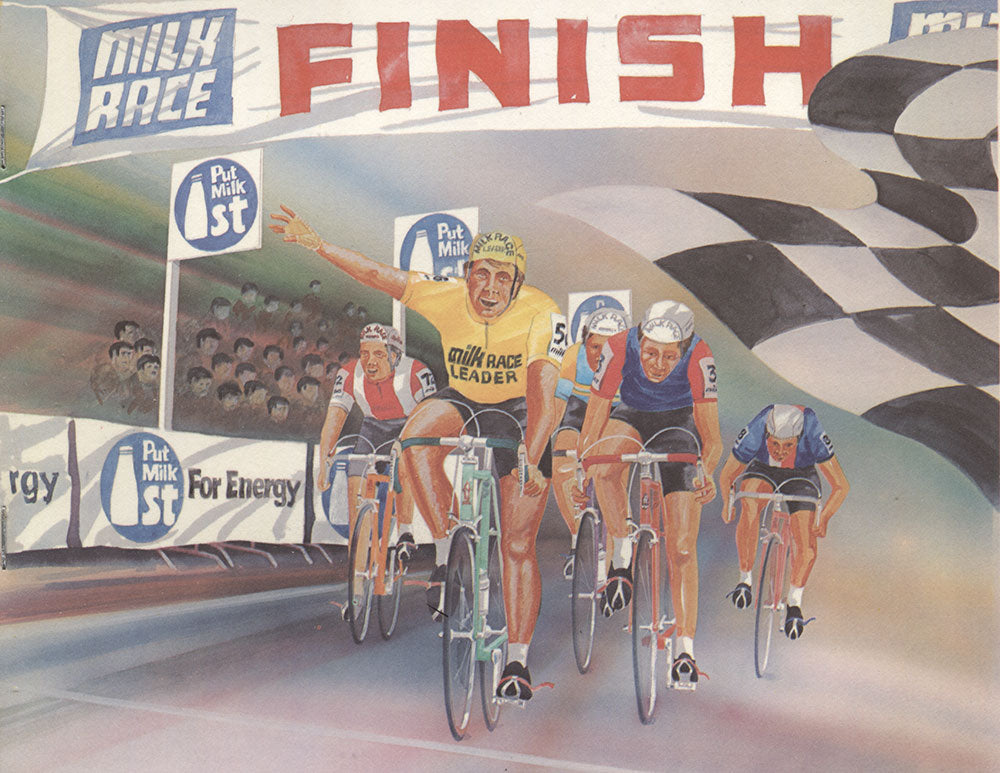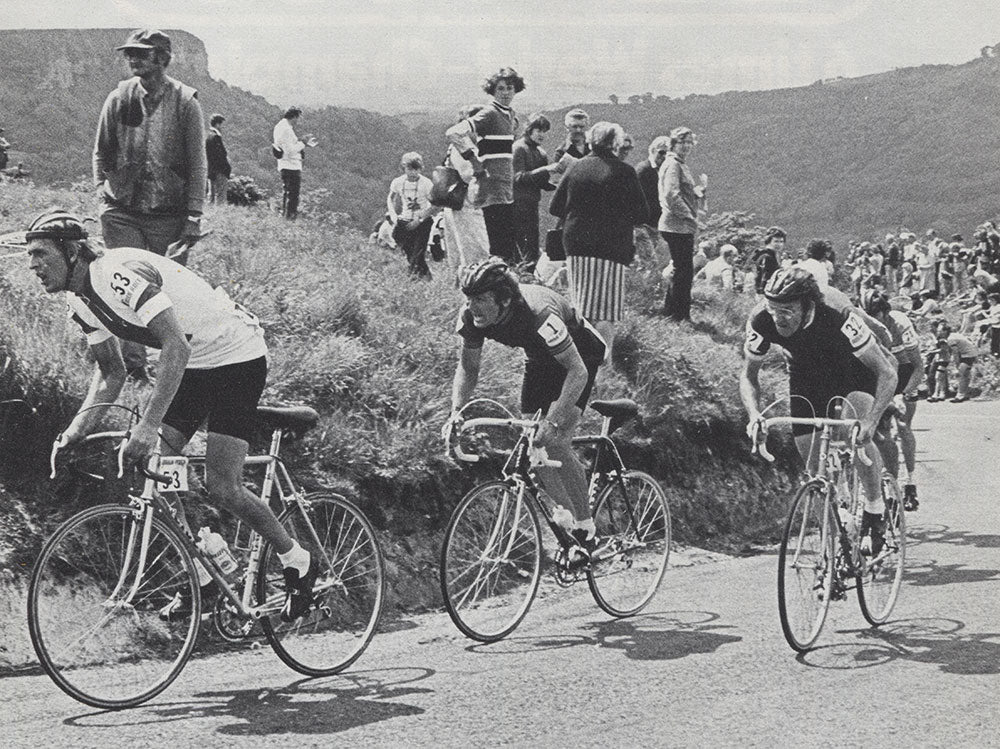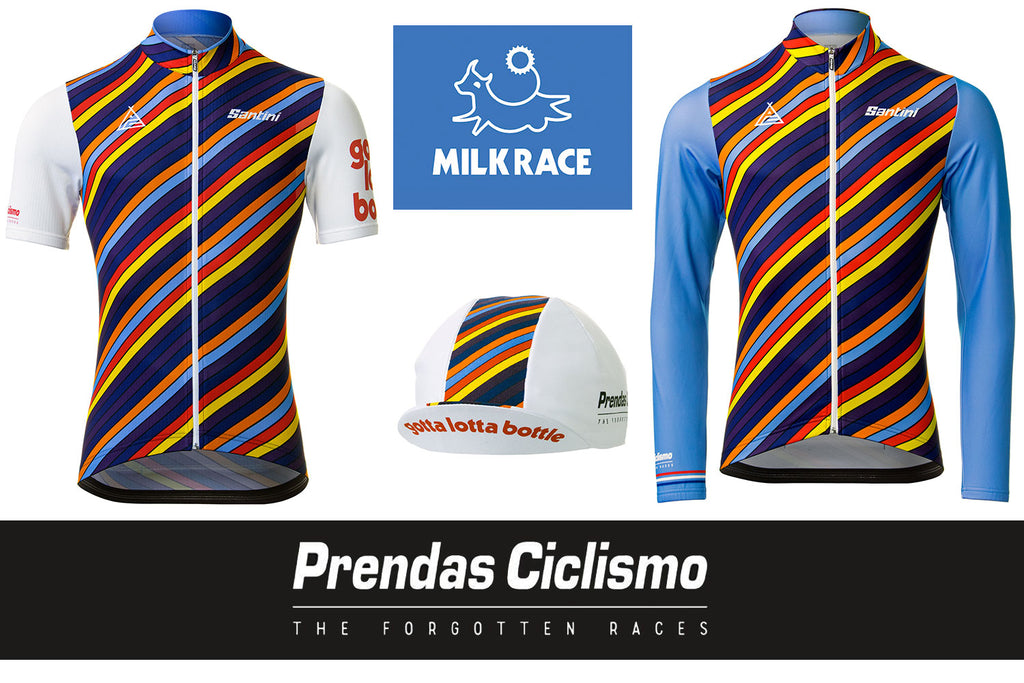QUALITY CYCLING CLOTHING SINCE 1996 - THE UK'S FIRST RETRO MANUFACTURER
QUALITY CYCLING CLOTHING SINCE 1996 - THE UK'S FIRST RETRO MANUFACTURER
RETRO APPAREL
COLLECTIONS
Cycling Clothing
ACCESSORIES
Forgotten Races: The Milk Race
February 20, 2019 5 min read

Join respected author, journalist & launch magazine editor of both Cycle Sport & Procycling William Fotheringham who takes us back in time to his recollections of the Milk Race.
Of course I saw the Milk Race when I was young. We all did didn’t we?
That was precisely the point about it; it was the original round-Britain cycle race and it went pretty much everywhere, so everyone got to watch it. It even came down the Exeter bypass one afternoon in 1982 en route from Bournemouth to Paignton where the hotels have moose heads hanging on the walls and are run by stressed out Basils.
I skived off school with a mate and went to have a look. The race didn’t amount to much as the peloton blasted past, but the announcer gave me a bit of a big-up: “nice looking curly Hetchins you got there mate,” he shouted over the Tannoy. No one had ever said anything that pleasant about the 25-year-old bike my dad had found in a shed for me.
It was a very well organised event with top class hotels and a safe racing environment. Although it was pro-am, we'd have to face the might of the best riders of the Soviet Union and the other East Bloc countries like Poland and Czechoslovakia, all who would have been very good pros.
I was proud to be part of the winning team when Joey McLoughlin won for ANC and have many other fond memories except the fact that I never won a stage. In 1989 I was second in the prologue and was second in Leicester which I am still gutted about to this day!
Tim Harris. Former National Champion.
The Milk Race was more than just a way of getting 16-year-old lads hooked on the glamour of cycling of course. I knew about its tradition from reading my hero Geoffrey Nicholson. “I came upon the Tour de France by way of Whitley Bay and Morecambe,” he wrote at the start of The Great Bike Race. “’Another gruelling 125 miles today’, said the announcer. ‘And do you know what the riders have in their gruel? Milk, ladies and gentlemen. They have milk.”
The Milk Race had its roots in the BLRC’s Brighton-Glasgow in 1945 and became the focal point of the UK calendar from the early 1960s thanks to a sponsorship match made in heaven with the now-defunct Milk Marketing Board. It became the event that all aspiring top British amateur cyclists aimed to compete in. It bred riders like Bill Bradley and later Joe Waugh, who never enjoyed high profile professional careers but were a force to be reckoned with when Milk Race time came.

Put Milk 1st For Energy was the slogan from the Milk Marketing Board. Artwork from the 1981 race manual, that details every stage the riders rode of the 1,080.5mile (1739km) route.
Much of the tradition went back to the early organiser Chas Messenger, whose missions “over the brown” – his personal codeword for moorland – led to some true epics, such as the 155-mile leg in 1962 from Rhyl to Cheltenham. Bill Bradley, the winner in 1959 and 1960, recalled stages where riders started at 10 in the morning and finished in the dark after getting lost. “We were going from Skegness to Manchester and all went off course at least twice, we rode round Lincoln trying to find our way, I got [to the finish] at dusk, but there were riders finishing hours after me.”
Bradley recalled immense distances – “hardly ever anything less than 100 miles” – and one stage where the riders were routed off a lane and across a ploughed field, not to mention constant arguments between the riders and Messenger over the toughness of the route. “A real killer,” said the 1966 winner Arthur Metcalfe, “up round north Yorkshire and Westmoreland… gated roads only five or six feet wide, really steep hills.” A year after his victory, Metcalfe started and finished the Tour de France.
Les West, one of the dominant riders of his time and another double winner, recalled that it wasn’t all grind. “It was bedlam. We were up all hours, getting to bed at 12, riding around in taxis heaven knows how late, out all hours. Everything you shouldn’t do, we did it – eating fish and chips, it was that much fun it was like a holiday. I was getting tired and sleeping well at night.”
I was lucky enough to watch the 1976 Aberystwyth queen stage with Bill Nickson, Phil Griffiths, Bob Downs and a certain Joe Waugh (who was such a gifted climber) using 42 x 23 over Devils Elbow, Staircase and the Bwlch/Rhigos - really tall gears compared to today's gearing!
Nickson won the day's stage and the overall classification by a slender 5 seconds from Waugh. Nickson went on to ride for TI Raleigh and take part in the Tour de France, whilst Joe Waugh would become a highly respected frame builder.
Martyn Hughes. Prendas customer.
“The one race that people in the street know about,” said the 1976 winner Bill Nickson a few years later. Nickson was a rare British victor in an era dominated by the grim-faced “professional amateur” Russians and Poles, to the extent that there were questions over whether the East Europeans should be allowed to ride.
The Milk Race’s nationwide reach meant that by the 1980s, it was better known to Britain’s armchair sports fans than the Tour de France. Around it was constructed a domestic amateur calendar including the great one-day races: the Grand Prix of Essex, the Tour of the Cotswolds, the Tour of the Peak and the others, of which only the Lincoln Grand Prix now survives.

Jan Kiewicz (Poland) leads Bob Downs (GB) and Billy Kerr (Ireland) on the 1st category climb of Sutton Bank.
The Milk Race was the centrepiece of a season-long narrative; the paradox was while it played the role in the British calendar that the Tour de France or Giro d’Italia do in their respective countries, it remained largely an amateur race. Even so, it was capable of putting on a central London finish in 1986, having moved on a long way from the day the Ministry of Agriculture flagged off the field with the words, “off you go lads, have a good rally!”
What did for the round Britain Tour, in the end, was the closure of the Milk Marketing Board in 1993 (many dairy farmers would say to the detriment of their industry which has been decimated since then, but that is another story). By then, the race was so closely identified with its main name backer that there was little point in another sponsor taking over. It remains the longest cycling sponsorship Britain has enjoyed, even if it was eventually killed off by its own success.
If you enjoyed this article, we've additional Milk Race blogs planned in the coming weeks, with Andy's visit in 1989 to watch the Milk Race in Bournemouth already published.
Also in News and articles from Prendas Ciclismo

Prendas' Best-Selling Caps of 2024
January 21, 2025 4 min read
With 2024 in the books, we're looking back at your favourite caps of the year. From cult classic movies to the jungle with a whole lot of Italian flair, check out our best-sellers and grab a new cap!

Vas-y Barry! Hoban wins Ghent-Wevelgem for Gan Mercier Hutchinson
May 15, 2024 8 min read
In an extract from his autobiography, Vas-y Barry, the only British winner of Ghent-Wevelgem, Barry Hoban tells how he won the cobbled classic in 1974, beating Eddy Merckx and the cream of Belgian cycling.

Our Best Selling Caps of 2023
January 15, 2024 4 min read
We know caps here at Prendas Ciclismo, and we know that you love all the styles we have on offer. So every year, we look back at our best-selling cycling caps for the previous year for you to discover a few new styles. Is your favourite cycling cap featured on our list? Read on and see!
Subscribe
Sign up to get the latest on sales, new releases and more …


